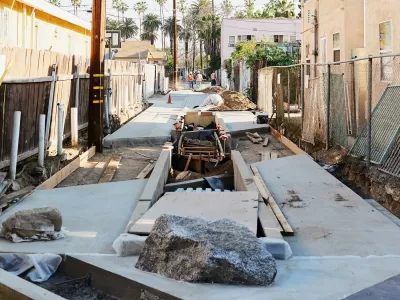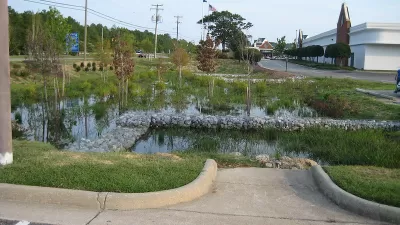Rather than shuttling stormwater away from the city and into the ocean as quickly as possible, Los Angeles is now—slowly—moving toward a ‘city-as-sponge’ approach that would capture and reclaim more water to recharge crucial reservoirs.

A program that installed green infrastructure in Los Angeles alleyways got its first real test last month as massive storms pummeled the region, bringing rain that overwhelmed much of Southern California’s stormwater infrastructure. As Alissa Walker writes in Curbed, thanks to the “green alleys” installed as part of a 2015 project in South Los Angeles, “the resulting stormwater had more opportunities to sink back into the earth: filtering through a row of permeable pavers, directing to pocket planters where creeping fig vines twirl up garage walls, or vanishing into grates labeled ‘drains to groundwater.’”
Walker explains that “a single green alley is able to capture enough stormwater per year to store it in dry wells below the pavers where it can slowly percolate into the groundwater, says Allen Compton, founder of the landscape architecture firm SALT, which designed these alleys.” The alleys connect to the South L.A. Wetlands Park, another key piece of green infrastructure that collects stormwater and provides habitat for local wildlife.
As storms become more intense and unpredictable, paved-over cities like Los Angeles can use permeable materials and sustainable design elements to capture and reclaim stormwater more effectively, recharge groundwater reserves, and prevent damaging floods. But “Because stormwater is still erroneously classified as a waste product, its management is handled by the same department that picks up the trash,” while other efforts are scattered across city and county agencies. According to Walker, Los Angeles is developing an interagency stormwater plan that would streamline and coordinate stormwater management efforts.
FULL STORY: L.A.’s ‘Green Alley’ Experiments Are Working”

Alabama: Trump Terminates Settlements for Black Communities Harmed By Raw Sewage
Trump deemed the landmark civil rights agreement “illegal DEI and environmental justice policy.”

Planetizen Federal Action Tracker
A weekly monitor of how Trump’s orders and actions are impacting planners and planning in America.

Why Should We Subsidize Public Transportation?
Many public transit agencies face financial stress due to rising costs, declining fare revenue, and declining subsidies. Transit advocates must provide a strong business case for increasing public transit funding.

Understanding Road Diets
An explainer from Momentum highlights the advantages of reducing vehicle lanes in favor of more bike, transit, and pedestrian infrastructure.

New California Law Regulates Warehouse Pollution
A new law tightens building and emissions regulations for large distribution warehouses to mitigate air pollution and traffic in surrounding communities.

Phoenix Announces Opening Date for Light Rail Extension
The South Central extension will connect South Phoenix to downtown and other major hubs starting on June 7.
Urban Design for Planners 1: Software Tools
This six-course series explores essential urban design concepts using open source software and equips planners with the tools they need to participate fully in the urban design process.
Planning for Universal Design
Learn the tools for implementing Universal Design in planning regulations.
Caltrans
Smith Gee Studio
Institute for Housing and Urban Development Studies (IHS)
City of Grandview
Harvard GSD Executive Education
Toledo-Lucas County Plan Commissions
Salt Lake City
NYU Wagner Graduate School of Public Service



























